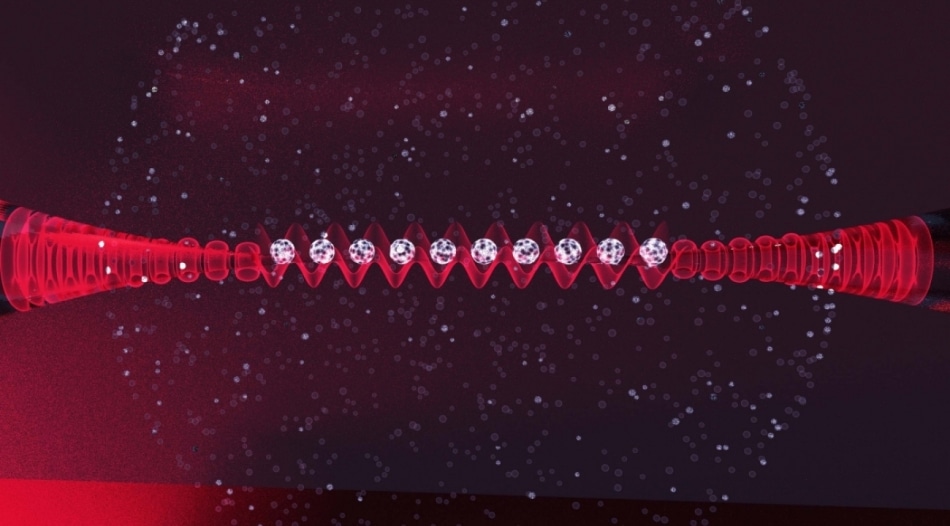Sep 28 2017
Optical fibers carrying light wherever it is required are considered to be ubiquitous. These glass tunnels are the high-speed railway of information transit, transferring data at unbelievable speeds over great distances.
Fibers are also flexible and thin, hence they are capable of being immersed in a wide range of environments, including the human body, where they are used for imaging and illumination.
 Cartoon graphic of a nanoscale optical fiber immersed in a chilled gas of atoms. Atoms from the gas are caught by the wiggles of light that surround the narrowest part of the fiber. Light waves propagating down the fiber both capture and probe the atoms, allowing scientists to study interesting light-matter physics. (Credit: E. Edwards/JQI)
Cartoon graphic of a nanoscale optical fiber immersed in a chilled gas of atoms. Atoms from the gas are caught by the wiggles of light that surround the narrowest part of the fiber. Light waves propagating down the fiber both capture and probe the atoms, allowing scientists to study interesting light-matter physics. (Credit: E. Edwards/JQI)
Physicists also use fibers especially those who study quantum information science and atomic physics. Besides shuttling laser light around, fibers can be employed for creating light traps for super-chilled atoms. Captured atoms are capable of interacting in a more powerful manner with light, much more so than if they were moving freely. This rather artificial environment can be employed for exploring basic physics questions, such as how a single particle of light works together with a single atom. However, it may also help with developing future hybrid atom-optical technologies.
Presently, Researchers from the Joint Quantum Institute and the Army Research Laboratory have produced a non-invasive, fast-acting way to use fiber light in order to reveal information about fiber traps. This technique is considered to be reminiscent of chemical and biomedical sensors that make use of fibers for detecting properties of neighboring molecules.
Fiber sensors are an attractive measurement tool as they can frequently extract information without completely disrupting interesting phenomena that may be going on. The research was featured as an Editor’s Pick in the journal Optics Letters. A review article about optical nanoscale fibers was also published by the team in the latest volume of Advances in Atomic, Molecular and Optical Physics.
Typical optical fibers, like the those used in medicine and communications, have only a small amount of light near the outside surface, and that is not sufficient for capturing atoms from a surrounding gas. Physicists can in fact push more light to the outside by reshaping the fiber to look like a small hourglass instead of a tunnel. The waist of the hourglass is hundreds of nanometers, a few times the width of a strand of human hair and extremely small to contain light waves that propagate along the inside of the fiber.
However, instead of just stopping at the constriction, the light indeed squeezes to the outside surface. The light waves blend together to produce a stationary ripple around the constriction when Physicists inject light into both ends of such a fiber. Atoms will be attracted to dips in the wave and then line up just like a row of eggs in a carton.
This trapping is considered to be an example of how light affects atoms, pulling them in. But the light-atom relationship is reciprocal: The existence of atoms can also modify the light. Light waves, transferred into one end of a nanoscale fiber, will obtain information about the atoms in the neighborhood of the fiber, and then transfer it to a detector at the opposite end of the fiber.
Each trapped atom behaves like a marble in a glass bowl. A marble, when pushed, will roll up the side of the bowl, back down and then up the other side. The speed of this cycle is associated with the bowl’s curvature: Steeper walls lead to faster cycles. Now envision shining a flashlight via one side of the bowl. The marble will keep traveling through the flashlight beam as it goes back and forth. The beam signal will blink on and off at the rate at which the marble was traveling in the bowl. In other words, the information about the marble motion, and thus the bowl’s shape, is encoded onto the flashlight beam.
The team uses laser light as the probe, analogous to the flashlight, in this research.
A mere 70 nanowatts in power is injected into the fiber, slowly kicking the atoms into motion. The atoms rock back and forth in their bowl traps similar to marble wobbles. Instead of making the probe light to blink on and off, the atom motion affects the direction in which the light waves oscillate. The speed of the atom rocking, which is directly linked to the atom trap shape, will be imprinted on the light as slower or faster changes.
The team catches the light waves with a detector to constantly monitor the atom-light oscillations when the light waves complete their journey and exit the fiber. The process is fast as it takes only a fraction of a millisecond, and it can be flawlessly incorporated into an experimental sequence.
When it comes to measuring these atom trap properties, Physicists desire to evade disturbances. This can be difficult to perform as one of the most effective ways to probe atoms includes blasting them with light, which can heat and also discharge them from their traps. This standard method is acceptable since Scientists can simply recool and recapture the atoms. In contrast, the JQI-ARL technique employs extremely little light and is done in-situ, meaning it gathers information while reducing disruptions. This attractive alternative guarantees to streamline atom-fiber experiments.